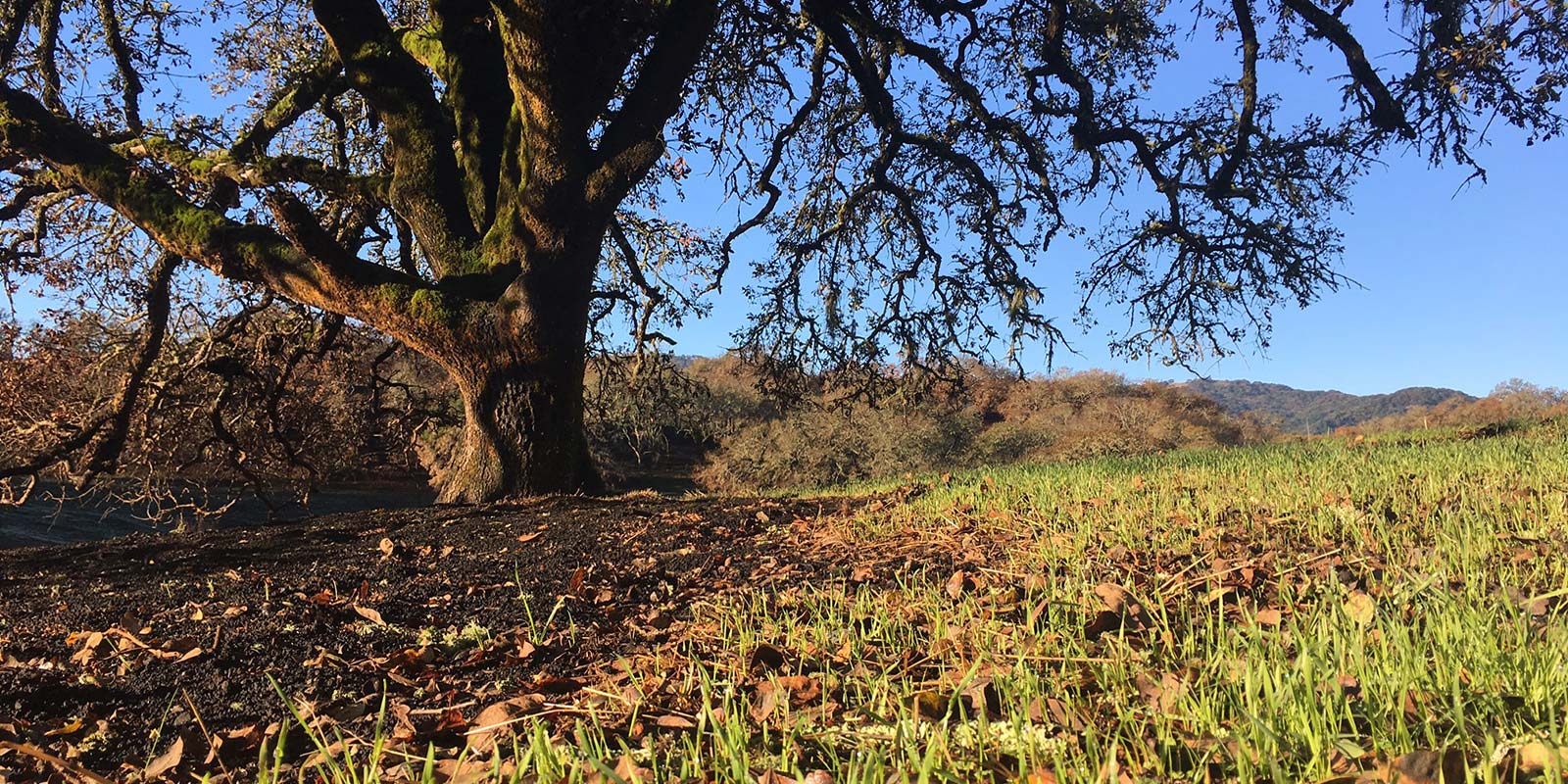Seeds and squirrels: Nature’s approach to fire recovery
It’s a lovely thought, but one that should be strongly advised against. Sonoma County’s forests, woodlands, shrub lands and streamsides already have a plan for recovery. In fact, they’ve planned for wildfires for a long time. And they have bounced back from many fires over thousands of years.
Fire-adapted landscapes

Nearly every tree species affected by the fires of 2017 and 2020 has a strategy for returning. Some, like coast live oak, have thick bark and may still be standing with green canopies hanging over blackened understory in places like Sonoma Valley Regional Park. Trees in this condition will be helped in the years to come because the competition around their bases is gone. If burned, coast live oak have an amazing ability to sprout from the trunk. This can happen within two months of a fire or sometimes takes two to three years. It all depends on how much energy is stored in their roots and how the weather plays out.
In fact, most oak species, along with many other native plants, have this ability to re-sprout, even when the above-ground portions of the trees are completely charred.
Black oak is a species that isn’t quite as hardy in the face of fire as coast live oak, but it still has a plan for regeneration. Because it is deciduous, fall fires have plenty of dry leaves to catch, spread and hold the fire. That said, black oaks have large reserves of nutrients and water that support prolific sprouting. Chances are you’ve seen mature black oaks that grow from many trunks, an indication they survived fires from years before.
Black oaks, like most other oaks, also reseed from acorns that fall on freshly burned soil or are brought in by squirrels and scrub jays who actually prefer burned sites to cache food for winter. The Creekside Trail in Shiloh Ranch Regional Park will be a place to observe black oaks rebounding.
Natural seed banks

For plants that didn’t survive the fires or can’t regrow, many have put down abundant seed into the soil. This “natural seed bank” is critical for recovery. In sites where the burn severity is low to moderate, the seed bank will readily respond in the months to come. Plants like the manzanita on Hood Mountain’s ridges largely depend on this strategy. Their seeds can persist for more than 40 years under the shade of their parent plants and only germinate after fire.
Many wildflower species are also represented in the natural seed bed and will respond next spring as rains subside and temperatures warm. Reny Parker, a well-known California Native Plant Society member, shared these photos showing how the seedbank responded after the Lake County fires. We will see this kind of response in our burned parks.
When is re-seeding necessary?
CAL FIRE experts recall the time 50 years ago when their post-fire approach was to spread rye grass seed from helicopters to prevent erosion. What they found was it actually made the situation worse because the grass seed out-competed the native vegetation and didn’t hold the soil together as well as the natural plants would have.
The same is true with “re-seeding” the parks. We have to be careful we are not accidentally replacing plants already on site. Even “native” seed is not necessarily representative of the plant community that existed pre-fire and will respond on its own post-fire.
For more severely burned sites, birds, animals, and the wind will bring in seed. The knobcone pine is a tree controlled exclusively by fire. Only temperatures of 400 degrees or more can melt their cones and release their seeds. Knobcones have long “wings” attached to their seeds, so the seeds can readily catch drafts and travel miles. Knobcone pine are doing this in real time on the highest points in Hood Mountain.
So, bottom line, park vegetation will come back on its own, with a few exceptions. We have areas heavily impacted by fire suppression, areas where dozer lines, hand lines, and staging areas were cut into the landscapes. Those areas require active seeding and stabilizing. A Press Democrat article showed photos of one place we put native seed and straw on Hood Mountain. It was by far the exception to the rule and represented a place where so much soil had been disturbed that active seeding made sense.
Wildlife will return

So what about the squirrels? And all of the other animals that live in these forests? Where are they now? Larger animals likely ran from the flames and took shelter in nearby unburned areas. Others sheltered in place. Ground squirrels and other rodents can stay underground, and we already see them active in the burned areas. Tree squirrels found refuge in tall trees above the flames or in unburned patches.
To be sure, some wildlife perished, but research shows the vast majority can get out of the way of fire and will return. They will make good use of hollow stumps for shelter, downed trees for dens, piled brush for protection, and they will feed on seed and sprouts as available. In their travels, they will spread the seeds and inoculate the soil with tiny fungi that support seedling growth. The seeds support the squirrels, and the squirrels support the seeds.
The forests and wildlife of Sonoma County will be resilient. They will recover. They will rebuild.
Melanie Parker is the deputy director of Sonoma County Regional Parks.



 Translate
Translate